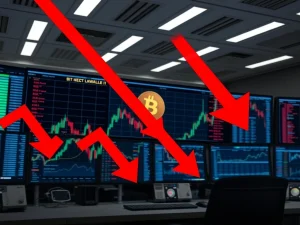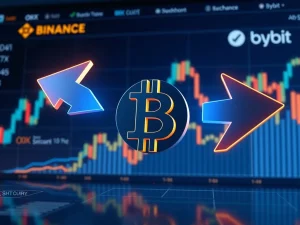Japan US Trade Deal: Unveiling a Monumental $550B Investment for Crucial Tariff Cuts

In the intricate dance of global economics, major trade agreements often ripple far beyond national borders, influencing everything from supply chains to market sentiment. For those navigating the volatile seas of cryptocurrency, understanding these macro-economic shifts is paramount. The recent announcement of a monumental Japan US trade deal, involving a staggering $550 billion investment from Tokyo into key American sectors in exchange for significant tariff reductions, is one such event that demands attention. While not directly about digital assets, this agreement underscores the shifting tides of global capital and strategic alliances, factors that invariably shape the broader financial landscape where crypto thrives.
The Core of the Japan US Trade Deal: A Strategic Exchange
Japan’s Prime Minister Shigeru Ishiba has signaled a strong commitment to finalizing a crucial trade agreement with U.S. President Donald Trump. This proposed deal, initially announced in mid-July, centers on Japan investing up to $550 billion into various U.S. sectors. In return, the U.S. would lower tariffs on Japanese exports, specifically from 25% to 15%. This substantial investment targets vital areas of the American economy, including:
- Critical Minerals: Essential for a range of high-tech industries, from electronics to defense.
- Pharmaceuticals: A sector crucial for public health and innovation.
- Semiconductors: The foundational technology for nearly all modern digital devices and AI development.
Ishiba emphasized the agreement’s importance, describing it as a “key responsibility” for Japan to advance national interests, particularly amidst internal political pressures. The precise terms of this Japan US trade deal remain fluid, with U.S. Treasury officials confirming ongoing negotiations and no formal written agreement yet finalized.
Understanding the Bilateral Investment: More Than Just ‘Seed Money’?
The proposed $550 billion figure has been a point of differing interpretations. President Trump initially framed these funds as “seed money,” implying new capital with a significant portion of profits directed back to the U.S. However, Japanese officials have provided clarification, suggesting that the $550 billion could involve existing capital rather than entirely new investments. This distinction is important for understanding the true economic impact and the nature of this bilateral investment.
Japan’s chief trade negotiator, Ryosei Akazawa, has further clarified that the deal, as it stands, lacks legally binding obligations or Trump’s proposed quarterly compliance reviews. He stressed the need for a joint statement to align interpretations and ensure mutual understanding of the commitments.
Navigating Tariff Negotiations: A Win for Japanese Exports?
The primary incentive for Japan in this agreement is the significant reduction in tariffs on its exports to the U.S., dropping from 25% to 15%. For an export-driven economy like Japan, such a tariff cut can have substantial benefits:
- Increased Competitiveness: Lower tariffs make Japanese goods more affordable and competitive in the U.S. market.
- Boost to Key Industries: Sectors heavily reliant on U.S. exports, such as automotive and electronics, could see improved profitability and market share.
- Stabilized Trade Relations: The agreement aims to mitigate the impact of ongoing trade tensions and provide a more predictable environment for Japanese businesses.
Analysts view this agreement as part of President Trump’s broader strategy to use trade policy as leverage to secure large-scale foreign investments. This pattern has been observed in recent negotiations with the EU and could potentially extend to future discussions with nations like China, highlighting the dynamic nature of current tariff negotiations.
The Broader Global Economic Impact: Setting a Precedent?
Beyond the immediate benefits for Japan and the U.S., this agreement carries significant geopolitical implications and could have a ripple effect on the global economic landscape. U.S. Commerce Secretary Howard Lutnick suggested the agreement could serve as a template, potentially pressing other nations, including South Korea, into similar arrangements. This approach of tying investment commitments directly to tariff cuts might reshape future international trade discussions.
While the deal aims to stabilize U.S.-Japan economic relations, critics warn that Trump’s strategy risks creating dependencies that could be vulnerable to renegotiation under future administrations. The absence of binding legal terms further amplifies these concerns, raising questions about the long-term viability and the true global economic impact of such deals.
Strategic Alliances and Domestic Pressures: A Balancing Act
Prime Minister Ishiba’s commitment to the trade deal comes amidst considerable domestic scrutiny, with opposition groups calling for his resignation. His decision to remain in office appears closely tied to advancing this trade agreement as a core economic priority for Japan. This highlights the complex interplay between international diplomacy and internal political dynamics.
However, the reliance on state-backed institutions, such as the Japan Bank for International Cooperation, to fund this massive investment raises concerns about transparency and fiscal sustainability. While strengthening strategic alliances, critics question the long-term financial burden and the potential for these arrangements to become “slush funds” lacking proper oversight.
Uncertainties and the Path Forward
The success of this ambitious agreement hinges on the execution details. Key questions remain: Will the $550 billion truly represent new capital, or will it primarily reallocate existing funds? How will project specifics and governance be managed, especially given that Japan’s Cabinet Office indicated investments would be overseen by state-linked entities?
Neuberger Berman, a U.S. asset manager, noted that the deal could bolster Japan’s equity positioning if the investments strategically align with sectors like technology and infrastructure. However, the current lack of clarity on these crucial details leaves the agreement’s long-term viability uncertain. Both nations face the challenge of translating a broad pledge into concrete, mutually beneficial outcomes that withstand political shifts and economic realities.
Conclusion: A Pivotal Moment in Global Trade
The proposed $550 billion investment from Japan into U.S. sectors, in exchange for reduced tariffs, marks a pivotal moment in international trade relations. This complex Japan US trade deal reflects a strategic maneuver by both nations to secure economic advantages and reinforce geopolitical ties. While offering potential benefits like increased market access for Japanese exports and significant capital injection into U.S. industries, the agreement is also fraught with uncertainties regarding its execution, financial transparency, and long-term stability. As negotiations continue and details emerge, the world watches to see if this ambitious pledge will solidify into a durable framework for future bilateral and global economic cooperation, setting a new precedent for how nations conduct their trade and investment policies.
Frequently Asked Questions (FAQs)
Q1: What is the core of the proposed Japan US trade deal?
A1: The deal involves Japan pledging up to $550 billion in investments into U.S. sectors like critical minerals, pharmaceuticals, and semiconductors. In return, the U.S. would reduce tariffs on Japanese exports from 25% to 15%.
Q2: Is the $550 billion investment entirely new capital?
A2: There are differing interpretations. While U.S. President Trump initially framed it as new “seed money,” Japanese officials have clarified that the figure could include existing capital rather than solely new investments.
Q3: What are the main benefits for Japan from this tariff reduction?
A3: Lower tariffs (from 25% to 15%) would make Japanese exports more competitive in the U.S. market, potentially boosting industries like automotive and electronics, and stabilizing overall trade relations.
Q4: Are the terms of the agreement legally binding?
A4: According to Japan’s chief trade negotiator, Ryosei Akazawa, the current proposed deal lacks legally binding obligations or formal compliance reviews. Both sides are working towards a joint statement to align interpretations.
Q5: How might this deal impact other countries?
A5: U.S. Commerce Secretary Howard Lutnick suggested this agreement could serve as a template to pressure other nations, such as South Korea, into similar investment-for-tariff-cut arrangements, potentially reshaping global trade policy.









